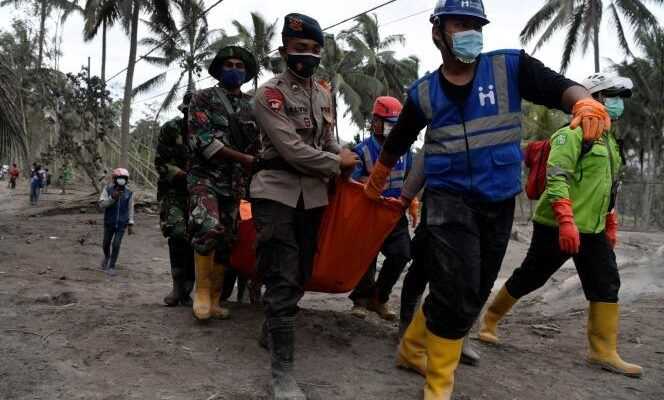Indonesian volcano Semeru again threw ash on Monday, December 6, slowing relief efforts to search for survivors after the spectacular eruption over the weekend, which devastated several villages and left 15 dead, according to a latest report.
The highest peak of the island of Java threw a vast plume of ash on Saturday and caused waves of burning mud which invaded villages located on its sides. More than a thousand panicked residents had to be evacuated. The eruption left at least 15 dead and dozens injured, 27 people still missing, according to a latest report released Monday by the disaster management agency.
In aerial photos, entire streets can be seen filled with piles of gray ash and mud, covering trucks or houses up to the roof. “I still hope to find my son (…) Every time I hear that a victim has been found I hope it is my son ”, said Maskur Suhri, who was harvesting palm sap when the Semeru erupted.
“There’s a very small chance he survived. Maybe it’s his fate, but I still hope to find him, if only his body “, continues this inhabitant of the village of Sumberwuluh.
Relief operations were slowed down due to a resumption of volcanic activity Monday morning, which forced some teams to stop their work. “There was a new eruption and this could endanger the evacuation teams”, explained a rescuer, Rizal Purnama.
Later, rescuers in orange clothing and hard hats would resume searching the ashes and mud in an attempt to find survivors and bodies, as fumes continue to rise from the ashes.
Their task becomes even more difficult as the volcanic debris hardens. ” It’s very difficult (…) with simple tools “, remarks Rizal Purnama. “It is very likely that the bodies that are not found are buried under the waves of hot mud. “
Missing mine workers
Authorities have asked residents not to approach within five kilometers of the crater, as the air saturated with ash dust in the area is dangerous for vulnerable people.
Ash from the eruption spread four kilometers, according to the Indonesian Geological Agency. The office of a sand mine was buried after the eruption, trapping 15 people in and around, says Hasim, a 65-year-old foreman who like many Indonesians has only one name.
“We have no news. Only one worker was saved, he is in the hospital with burns ”, he said. Some victims were buried alive in their vehicle, without having had time to escape, rescuers reported. Suwarti Ningsi was trapped for five hours in her home with her daughter.
“I couldn’t see anything anymore, it was like night. Everyone was panicking ”, said the 42-year-old Indonesian woman: “I could only pray (…) so that me and my daughter are saved. “
Rain forecast for the area over the next few days could further complicate the work of rescuers, as it risks forming ash flows and hot mud. The Semeru, the highest peak in Java which rises to 3,676 meters, has known many eruptions in recent decades but rarely so destructive.
Its last major eruption was in December 2020. It had also caused the flight of thousands of people and covered entire villages. Since this episode, the authorities had maintained the alert level of the volcano at the second highest.
Indonesia is located on the Pacific ‘Ring of Fire’, where the meeting of the continental plates causes high seismic activity. The Southeast Asian archipelago has nearly 130 active volcanoes on its territory. At the end of 2018, a volcano eruption between the islands of Java and Sumatra had caused an underwater landslide and tsunami, killing nearly 400 people.
